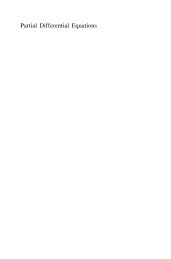a Matlab package for phased array beam shape inspection
a Matlab package for phased array beam shape inspection
a Matlab package for phased array beam shape inspection
You also want an ePaper? Increase the reach of your titles
YUMPU automatically turns print PDFs into web optimized ePapers that Google loves.
30 7 SNR ESTIMATE FOR THE TEST ARRAY<br />
6.2. Results<br />
b) Histogram of the <strong>beam</strong> direction change around the value θ 0<br />
∆θ = θ 0 trial − θ0 .<br />
The mean value and standard deviation of ∆θ over the trials is shown in line<br />
three of the plot header.<br />
c) Histogram of the <strong>beam</strong> width change from the computed value W 0 of the<br />
undistorted <strong>beam</strong>,<br />
∆W = W trial − W 0 .<br />
The mean value and standard deviation of ∆W over the trials is shown as<br />
the last item in line three of the plot header.<br />
Figures 21-24 show the <strong>beam</strong> <strong>shape</strong> jitter characteristics <strong>for</strong> a 50 × 20 element <strong>array</strong><br />
when the timing jitter at the elements varies from 100 ps to 1000 ps. In all cases, we<br />
assumed amplitude jitter 0.2 around the undistorted value of 1.0, (and normalized the<br />
amplitude power sum to unity). The <strong>beam</strong> width, in the xz-plane in this vertical pointing<br />
is W = 0.68 ◦ . This means that if we can accept 0.1 × W errors in pointing, in essentially<br />
no simulation run, should ∆W exceed 0.07 ◦ . The panel (b) of the figures show that<br />
this requirement clearly is fulfilled <strong>for</strong> timing jitter up to 500 ps, but starts to become<br />
questionable at the timing jitter of 1000 ps. The changes in <strong>beam</strong> width are similarly<br />
small up to about 500 ps.<br />
What is, perhaps, more troublesome is the loss of gain. At ∆t = 100 ps, the mean<br />
loss of gain in the main <strong>beam</strong> is about 10% (0.5 dB), at ∆t = 300 ps the loss is about<br />
25% (1.3 dB) and at 500 ps about 50% (3.0 dB).<br />
We emphasize that the loss of gain is mostly due to the “incohence” caused by the<br />
phase jitter. If we keep in the above four runs the input parameters otherwise intact but<br />
set the element amplitude jitter to zero, the <strong>beam</strong> jitter distributions change very little<br />
from those shown in Fig. 21-24. For example, the gain loss at 500 ps reduces from the<br />
50% to about 44%.<br />
Unless there is some fundamental problem with these simulation, it appears very clear<br />
that to get, say 0.1×<strong>beam</strong>width pointing accuracy, it is definitely enough to be able<br />
to control the element phase with something like 10–20 ◦ accuracy (clock timing with<br />
100–300 pc accuracy at 225 MHz), as long as the phase errors at individual elements are<br />
uncorrelated. The large number of elements (1000 in this simulation) then takes care<br />
about averaging the distortions so that the main effect is just some loss of gain. The<br />
randomness of the timing/phasing errors at the elements is so important that it perhaps<br />
should be en<strong>for</strong>ced.<br />
7. SNR estimate <strong>for</strong> the test <strong>array</strong><br />
To get a rough estimate of SNR <strong>for</strong> the Kiruna test <strong>array</strong>, assume that the test <strong>array</strong> is<br />
oriented towards the VHF antenna, long size (the x-direction) towards the VHF antenna,<br />
and that the VHF antenna is perpendicular to that direction, at x = L = 200 km in<br />
the test <strong>array</strong> coordinate system, and assume that the line from the test <strong>array</strong> to the<br />
VHF antenna is perpendicular to the VHF vertical direction (“flat Earth”), see Fig. 25.<br />
Also, assume optimal polarization matching and assume that the angle χ between the
















